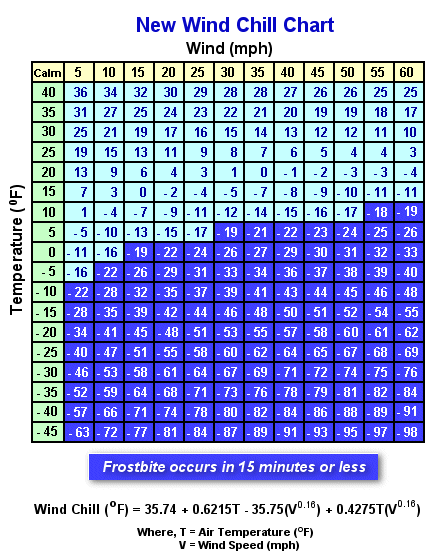Wind Chill Chart
Dec 4, 2018 10:41:45 #
There was an outside chance that one of my Navy assignments was to go to the South Pole.
In preparation for that I looked up the wind chill factors so that I could have my cameras
ready by changing out the lubrication to keep them functioning. More than that I had to
know what extreme cold would do to me under those conditions. Hypothermia is a very
real threat not only to the camera but also to the photographer. So for those of you who
are foolish enough to ignore how easy it is to get frostbite or worse here is a wind chill
chart to give you what you need to know. This also applies to people who do aerial
photography. With digital cameras cold will increase your battery drain disproportionally
which is one more reason to know before you go into the cold.
Note that frostbite can occur in 15 minutes or less in the blue section of the chart.
In preparation for that I looked up the wind chill factors so that I could have my cameras
ready by changing out the lubrication to keep them functioning. More than that I had to
know what extreme cold would do to me under those conditions. Hypothermia is a very
real threat not only to the camera but also to the photographer. So for those of you who
are foolish enough to ignore how easy it is to get frostbite or worse here is a wind chill
chart to give you what you need to know. This also applies to people who do aerial
photography. With digital cameras cold will increase your battery drain disproportionally
which is one more reason to know before you go into the cold.
Note that frostbite can occur in 15 minutes or less in the blue section of the chart.

Dec 4, 2018 12:27:28 #
Good post - a lot of folks don't realize how quickly wind chill can affect them.
In the '70's, I taught motorcycle safety at the Naval Air Technical Training Command, Memphis and incorporated wind chill charts in the class. Quite a few riders were not aware that at 50° and 50 mph they were susceptible to frost bite.
In the '70's, I taught motorcycle safety at the Naval Air Technical Training Command, Memphis and incorporated wind chill charts in the class. Quite a few riders were not aware that at 50° and 50 mph they were susceptible to frost bite.
Dec 4, 2018 13:21:11 #
Wind chill doesn't affect cameras, only people. While wind can help pull the heat from the camera, the camera itself will never be colder than the actual, ambient air temp. Wind chill is simply how it "feels" to a person, camera's don't care.
Dec 4, 2018 13:21:59 #
Precisely...
Steve Perry wrote:
Wind chill doesn't affect cameras, only people. While wind can help pull the heat from the camera, the camera itself will never be colder than the actual, ambient air temp. Wind chill is simply how it "feels" to a person, camera's don't care.
Dec 4, 2018 18:00:26 #
Steve Perry wrote:
Wind chill doesn't affect cameras, only people. While wind can help pull the heat from the camera, the camera itself will never be colder than the actual, ambient air temp. Wind chill is simply how it "feels" to a person, camera's don't care.
"... can help pull the heat from the camera ..." means that wind chill absolutely does affect cameras, and in just about exactly the same way it affects humans. In either case it determines how fast terminal temperature (ambient) is reached, and does not represent a temperature lower than ambient.
I've spent the last 20 years living in Barrow Alaska. I am not guessing!
Wind chill affects the cost of heating your house, whether your car will start, when the camera battery gives up the ghost... and when your skin freezes.
One thing for the OP though, don't worry about lubrication for the camera. It has been decades now since all camera lubs are synthetic, and literally are as good can be found.
Dec 4, 2018 18:34:21 #
Dec 4, 2018 19:09:49 #
Apaflo wrote:
"... can help pull the heat from the camera .... (show quote)
See the link provided above ( https://www.weather.gov/media/ict/handouts/WindChill_HeatWave.pdf ), I think you're mixing up wind chill and heat convection. Just because wind will take heat from an object faster than still air it doesn't mean that that object is colder than the ambient air, the way wind chill makes a human feel. Wind chill and the heat convection are two different things. See this page:
http://hyperphysics.phy-astr.gsu.edu/hbase/thermo/heatra.html
Wind chill is simply how cold the air feels to humans.
Dec 4, 2018 19:13:13 #
Dec 4, 2018 19:18:46 #
Pixelmaster wrote:
There was an outside chance that one of my Navy as... (show quote)
Cameras are not affected by "wind chill" which refers to how cold a human feels when exposed to wind. That resulting wind çhill number is ALWAYS lower than the ambient temperature. A human body loses heat two ways - convection, plus the heat loss from evaporation. But the key element in wind chill is how wind can make a person "fèel" colder than ambient temps. Cameras can't feel. But LCDs can freeze if it's cold enough.
A camera in cold conditions will NEVER be colder than the ambient temperature, no matter how hard the wind blows. Therefore they are a not affected by the wind chill factor. The speed that warmer camera drops to ambient temp will increase, but that is not exactly wind chill - it is convection.
You don't have to go to the Great White North to see wind chill in action. You only need a temp of 50 degrees or lower.
Dec 4, 2018 20:08:17 #
Gene51 wrote:
... A camera in cold conditions will NEVER be colder than the ambient temperature, no matter how hard the wind blows. Therefore they are a not affected by the wind chill factor. The speed that warmer camera drops to ambient temp will increase, but that is not exactly wind chill - it is convection.
So you think flesh can get colder than ambient? It can't, and by your reasoning will not be affected by wind chill. NOT!
Wind chill is a measure of how fast heat is removed, and that affects any object that is not at ambient temperature already. That is not convection, it is wind chill effect.
It is astounding, or maybe shameful, that a NOAA web site makes such ignorant statements that confuse people.
And while I am quite clear about effects of windchill at 50 degrees I doubt many others are.
Incidentally I had lunch with a long time friend who has spent twice as much time in Barrow as I have. We had a good laugh over this, and are in complete agreement. It is interesting that he also has for more EMS experience than I. He rescusiated a child that was documented to have spent 40 minutes underwater.
Dec 4, 2018 20:31:11 #
I think what may be missing is the concept that the human body is constantly producing heat and is substantially hotter than the ambient temperature. Wind increases the heat transfer to the environment, so the body looses heat faster, and the heat differential between normal human temperature and a very cold environment is substantial (and the heat transfer is proportional to the difference in temperatures). On the other hand, the camera produces very little heat from the processor (and almost none except when shooting), so the differential between it and the ambient temperature is very small, thus the transfer is small. With enough wind and convection, the camera can reach the ambient temperature, but not colder, and the decline in temperature will be very slow, not only because of the smaller differential, but also because of the small surface area of the camera body. The temperature of the human body can also reach ambient (after death), but the effect of wind on the temperature loss will be much greater, not only because of the higher temperature differential, larger surface area (and the more serious effects of rapid temperature loss).
Dec 4, 2018 21:29:17 #
Greeting from CANADA!
I will not even attempt to enter this argument. Thermodynamics ain't my area of expertise! All I know is that I have worked in some extremely cold conditions to the point where the cameras just seized up- I suppose the lubricants congealed, batteries failed, perhas circuitry was affected and/or things in the camera expanded and contracted leading to malfunction. I have also been out in sub-freezing conditions with significant wind-chill where the equipment worked faultlessly, however, my face nearly froze over and my hands felt like the were about to fall off- regardless of all the thermal clothing. In the old days the film could crack or on a cold dry day there were static marks if it was advanced too fast. Used to be that manufacturers recommended "winterizing" the equipment with specialized lubricants.
I am not an avid nature or wildlife shooter but I have a great deal of respect for the folks that do that work under inclement weather conditions and manage to come up with fine imagery. Most of my commercial work is done indoors, however, I do get a number of location jobs in the middle of Winter that require out-of- doors work and of course, the clients always pick the days and weeks with relentless record breaking low temperatures. Y'all are talking about WIND chill- what about relative humidity! It's DAMP up here in Eastern Canada. It gets right in your bones! How do you spell "hyperthermia"
Some folks like to say "It's hot as HELL"! I believe it's COLD in HELL!
I will not even attempt to enter this argument. Thermodynamics ain't my area of expertise! All I know is that I have worked in some extremely cold conditions to the point where the cameras just seized up- I suppose the lubricants congealed, batteries failed, perhas circuitry was affected and/or things in the camera expanded and contracted leading to malfunction. I have also been out in sub-freezing conditions with significant wind-chill where the equipment worked faultlessly, however, my face nearly froze over and my hands felt like the were about to fall off- regardless of all the thermal clothing. In the old days the film could crack or on a cold dry day there were static marks if it was advanced too fast. Used to be that manufacturers recommended "winterizing" the equipment with specialized lubricants.
I am not an avid nature or wildlife shooter but I have a great deal of respect for the folks that do that work under inclement weather conditions and manage to come up with fine imagery. Most of my commercial work is done indoors, however, I do get a number of location jobs in the middle of Winter that require out-of- doors work and of course, the clients always pick the days and weeks with relentless record breaking low temperatures. Y'all are talking about WIND chill- what about relative humidity! It's DAMP up here in Eastern Canada. It gets right in your bones! How do you spell "hyperthermia"
Some folks like to say "It's hot as HELL"! I believe it's COLD in HELL!
Dec 5, 2018 02:04:37 #
Apaflo wrote:
So you think flesh can get colder than ambient? I... (show quote)
No, Gene51 is basically correct. The only thing he got wrong is applying the term "convection" instead of "heat conduction".
Dec 5, 2018 02:29:55 #
rook2c4 wrote:
No, Gene51 is basically correct. The only thing he got wrong is applying the term "convection" instead of "heat conduction".
How can anyone be "basically correct" and claim the difference is whether something cannot get colder than ambient. In fact windchill does not make anything colder than ambient.
That is just one "basic" flaw!
But you are correct that it is heat conduction.
Dec 5, 2018 05:49:57 #
If you want to reply, then register here. Registration is free and your account is created instantly, so you can post right away.







